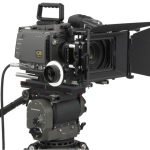Articles from: August 2009
Sony’s F23 – Breaking the Hollywood Circle
 It seemed not too long ago that film was THE way to go if you were serious about a career in Hollywood. But from David Gordon Green’s ‘George Washington’ back in 2000, to now Michael Mann’s recent ‘Public Enemies’, the process has taken a turn. Green wanted his film taken seriously so he shot it on 35mm, which granted did give it a unique look and feel, while fast forward 8 years, Michael Mann shot ‘Public Enemies’ with mostly digital cameras sighting the versatility and visual detail as the main reasons. So are we seeing the death of film in modern filmmaking?
It seemed not too long ago that film was THE way to go if you were serious about a career in Hollywood. But from David Gordon Green’s ‘George Washington’ back in 2000, to now Michael Mann’s recent ‘Public Enemies’, the process has taken a turn. Green wanted his film taken seriously so he shot it on 35mm, which granted did give it a unique look and feel, while fast forward 8 years, Michael Mann shot ‘Public Enemies’ with mostly digital cameras sighting the versatility and visual detail as the main reasons. So are we seeing the death of film in modern filmmaking?
I can remember as an editor, editing my first film shot on film on an NLE platform, instructing the director to get a high-res transfer at Deluxe Studio, having to re-sync the sound, making my cut, then exporting the sequence with my EDL for the transfer house to cut into a reel. There was something kind of nice about that. It wasn’t the easiest process but somehow knowing your work was deciding such a finale of a physical cut made all parties take extra care of their work. Now, the most common thing I hear is “If they (people) don’t like it, we’ll just re-cut it…”. It’s not that people don’t care, they just know they have unlimited opportunities to ‘get it right’. And there’s pro’s and con’s to that.
Sony’s F23 seems to be the new Hollywood staple for films considering the digital approach. While way out of consumer leagues, this hefty little beast is turning the heads of Hollywood’s movers and shakers, and is even cracking the 3D visceral world as well. While the Thomson Viper FilmStream has been the most common HD camera used in conjunction with this new digital era, as of late prominent filmmakers have shifted their approach to Sony’s F23. Distinguished mentions include Michael Mann’s ‘Public Enemies’, David Fincher’s ‘Benjamin Button’, and the new 3D flick ‘Final Destination 4’ just to name a few. Of all of these films are transferred to 35 mm film print for their theatrical releases which begs a different question, how long will filmmakers wait till the era of omnipresent digital cinema to arrive and take them away from the world of film prints altogether?
Some industry enthusiasts say that could be a matter of five to ten years away, given the dramatic leaps at which the digital realm seems to be storming Hollywood, but there are some recognized film icons such as John Carpenter, Martin Scorsese, and even Stephen Spielberg who vow that digital cinema will never be able to fully envelope the theatrical experience the way celluloid can or replicate the depth and color’s of a film look entirely. However, given all that, Sony’s F23 is certainly a real sign that this new era has reached a maturity for digital cinematography, and is making headway fast. The biggest segment to embrace the new camera is commercial production because of the Sony’s F23′ s offspeed capabilities. Band Pro clients Clairmont Camera and The Camera House, both in LA, have already rented the F23 for spot shoots.
“Until the F23 came along, cameras in the 2/3″ chip world were designed much like ENG cameras. The Sony F23 is designed like a film camera. It’s very operator friendly. And the test footage I’ve seen looks remarkable. Even with the gain set at 12 dB, the equivalent of ASA 2000, it is virtually noiseless. Add to that the ability to dock a recorder on the top or rear of the camera and you have a versatile unit that can be used in the studio, handheld or Steadicam modes. It’s a winner!” – Denny Clairmont
Digital Imaging Technician Nick Theodorakis’s first field encounter with the F23 was a Clairmont system on a Michael Mann directed Nike commercial shot by Dante Spinotti, ASC. Citing the cameras wide color gamut and 14bit Analog to Digital Converter, Theodorakis said,
“All in all, it adds up to a sharper, denser image that has never been available to us in a camera of this class”
It looks as though there is no stopping the evolution of what is the digital era, and for editor’s who have been living under a rock for the past 10 years, the process is certainly vastly different from the fine cutting of celluloid. It is a process which at this point, if you’ve only dabbled in, should be fully embraced, since it’s post production possibilties are endless with the latest of these technologies. Yes, Sony’s F23 and it’s HDCAM backroll are here to stay.
Final Cut Studio 3, the Pro’s Weigh In
 Well, here we are again. Final Cut Studio 3 has been out long enough now for people to have had the chance to get their spoonful of Apple’s new post production package. What are their thoughts? Well, as we know, e-v-e-r-y-o-n-e has an opinion (unfortunately) and rather than read the tumultuous ramblings of college students or editing wannabes I thought it would be a breath of fresh air to hear what actual studio based editor’s and facilities had to say about it.
Well, here we are again. Final Cut Studio 3 has been out long enough now for people to have had the chance to get their spoonful of Apple’s new post production package. What are their thoughts? Well, as we know, e-v-e-r-y-o-n-e has an opinion (unfortunately) and rather than read the tumultuous ramblings of college students or editing wannabes I thought it would be a breath of fresh air to hear what actual studio based editor’s and facilities had to say about it.
Editor Jonathan Moser (www.flashcutproductions.com) recently purchased the new release and commented:
“It’s not that there are any ‘knocking it out of the park’ features in the new FCP, it’s just well thought out enhancements and new features with increased dynamic interoperability between Studio’s different products. Again, Apple scores more in vision and image than Avid, whose new releases also incorporate increased functionality and versatility, but with much less fanfare…and that’s been Avid’s image problem vs. Apple’s the entire time. Avid was and is an editing company, Apple is more of an event creator, though FCP is and will remain a solid product that will continue to get increasing market share.”
LA-based television producer Tor Johansen also commented on the new release:
“Logistically, I’m excited to see Apple working off of their own timeline with this release. This whopper of an update comes out smack dab in the middle of…nothing. No NAB launch, no surprise announcement at the WWDC, and no ‘one last thing’ at the MacWorld keynote. It gives me more confidence in the shipping product, that it was put out when it was ready, not according to some fading industry calendar.”
Adam Luckwell, CEO of London’s Unit is also keeping close tabs on the new Final Cut package.
“We are obviously eager to use the latest upgrades and believe there will be great improvement to workflows. With the new Studio, Final Cut Pro brings improvements to some of the most frequently used tools and features, such as the powerful and easier to use speed tool, as well as the new ProRes codecs, offering the ability to create higher quality exports but at low file sizes. As well as improvements to existing features it also has the addition of new functions that will make both an editor and client’s life more productive. The new easy export function is an example of one of these, allowing users to set exports rendering out in the background while they are able to carry on working. This could seem like such a small change but in the commercials and advertising sector where approval mpegs are common place it will be especially useful.”
He also commented on the much more streamlined integration between Final Cut Pro and Color, which he believes will cut down on the prep work previously needed between the two.
“This will impact positively on prices as it means less man hours getting a project ready for the grade and will be especially useful in the case of long-form.”
It’s all interesting to hear, and although I haven’t officially commented yet since I’d prefer to take the full package for more than just a test drive before I way in, I did blog on my initial thoughts last month which were mixed. However, to reiterate some of my feelings, I think Apple has certainly taken some good steps here, but more assertively I have agree with editor Jonathan Moser :
“…Apple scores more in vision and image than Avid, whose new releases also incorporate increased functionality and versatility, but with much less fanfare. Avid was and is an editing company, Apple is more of an event creator, though FCP is and will remain (and I’ll ad in, ‘for the most part’ ) a solid product…”
I’ll leave it at that for now.
Motion 4 signifies the end of Shake
 With the release of Motion 4, packaged with Final Cut Studio 3, it seems like Apple has officially dropped it’s high end software program, Shake. First off, I wish to say that Shake is an excellent program, and I’m not the only one who thinks so. High end films such as Lord of the Rings, Harry Potter and the Dark Knight have all used Shake in their post production workflow. The real perplexing issue here is why has Apple abandoned such a well used and respected program. It seems like Apple is in the business of telling people what they want rather than listening to what they want. Meaning that rather than take an already solid and well-groomed program and expand with it, they bury it and try to force people to use their new Motion 4 instead. Now Motion has had some upgrades, the most notable and obvious being the ability to work in 3D textures and shadowing, but I can’t for the life of me figure out why that means dumping another popular and successful program. It’s almost as if they think that we’ll just start using Motion instead, when really Motion hasn’t had, nor has it earned, the respect of serious professionals. With other programs available, such as the very popular After Effects for example, my guess is that people will simply use programs like that more rather than start learning a new program that’s clearly at the beginning stages of it’s professional wannabe surge. And with these other programs having solidified their reputation on the market, Motion has a long way to go to get any real attention from the serious players.
With the release of Motion 4, packaged with Final Cut Studio 3, it seems like Apple has officially dropped it’s high end software program, Shake. First off, I wish to say that Shake is an excellent program, and I’m not the only one who thinks so. High end films such as Lord of the Rings, Harry Potter and the Dark Knight have all used Shake in their post production workflow. The real perplexing issue here is why has Apple abandoned such a well used and respected program. It seems like Apple is in the business of telling people what they want rather than listening to what they want. Meaning that rather than take an already solid and well-groomed program and expand with it, they bury it and try to force people to use their new Motion 4 instead. Now Motion has had some upgrades, the most notable and obvious being the ability to work in 3D textures and shadowing, but I can’t for the life of me figure out why that means dumping another popular and successful program. It’s almost as if they think that we’ll just start using Motion instead, when really Motion hasn’t had, nor has it earned, the respect of serious professionals. With other programs available, such as the very popular After Effects for example, my guess is that people will simply use programs like that more rather than start learning a new program that’s clearly at the beginning stages of it’s professional wannabe surge. And with these other programs having solidified their reputation on the market, Motion has a long way to go to get any real attention from the serious players.
Having said all that, I certainly don’t want to take away from the abilities of Motion or Apple’s attempt at pushing it up toward the next level. The new Motion 4 is a step in the right direction, and Apple has begun the stage of trying to make it a viable choice for those consummate professionals. However, the way Apple seems to be conducting it’s business tactics to achieve this, is just plain arrogant and foolish. For a company who waged the excellent marketing behind the iPhone and has since taken 28% of the cell phone market with this ingenious ploy, this is a rather disappointing setback and will not bold well for their PR.
Panasonic P2 Camera and Avid
I seem to get a lot of questions about shooting 24p from cameramen, as in what I would prefer from them as the editor who will have to deal with footage. Apparently there seems to be different opinions on how one should shoot in order to properly maintain the metadata for post. So I’ve grabbed a tutorial from Avid and posted it below for all to see. It’s not so much about post production as it is how to properly set up for your P2 camera for 24p and be able to properly edit the footage in post. I hope this gives you all some clarification.
